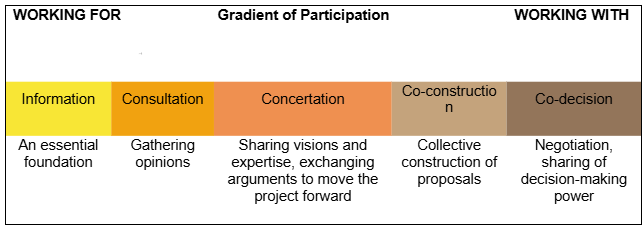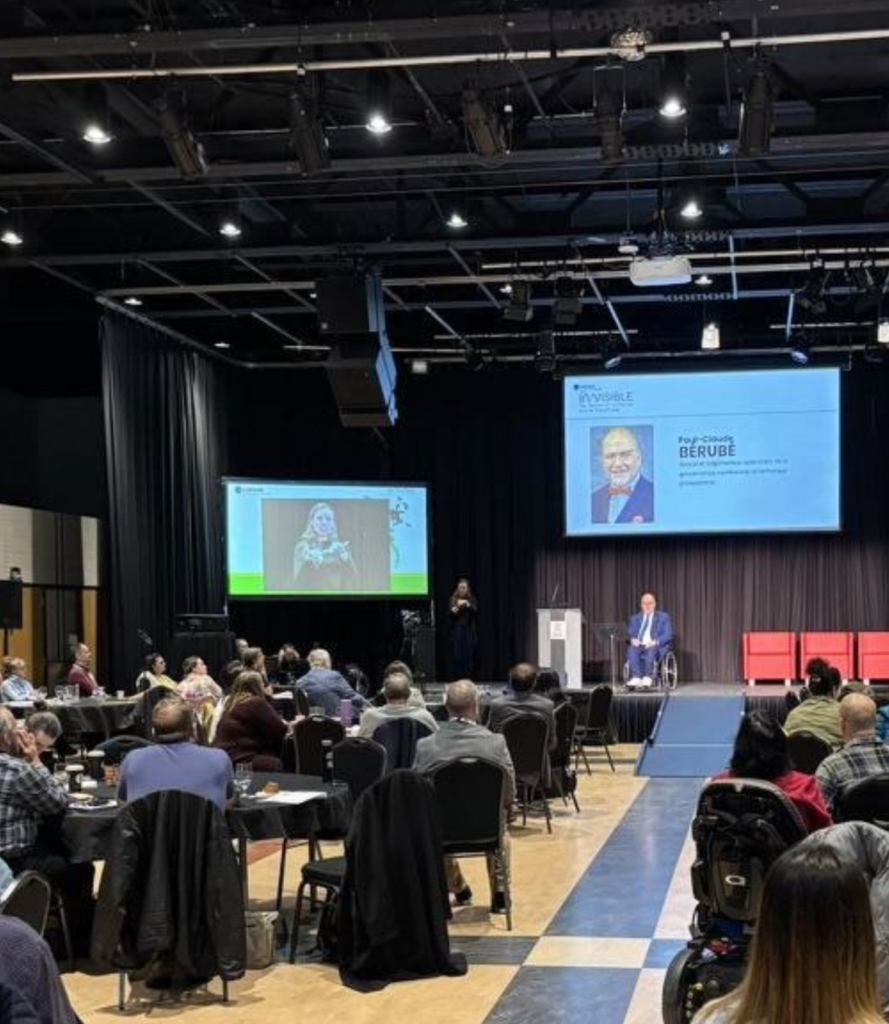
What is accessible and inclusive citizen engagement?
Accessible and inclusive citizen engagement means that all people, including those with disabilities, can fully engage in public life. This includes the right to information, freedom of expression, the right to vote and the opportunity to contribute to collective decisions. To achieve this goal, communities must implement concrete actions, such as involving persons with disabilities and their associations, organizing accessible consultations and using appropriate tools to remove barriers to participation.

Moving from “working for” to “working with,” the gradient of participation from CEREMA
This concept emphasizes the importance of working directly with those involved rather than deciding for them. True inclusion relies on constructive dialogue and co-creation of initiatives that meet everyone’s needs.
Overview of the situation
Persons with disabilities do not always feel recognized as citizens in their own right. They feel that their contributions are not valued by representatives of decision-making bodies. They feel that they are neither listened to nor heard. In some cases, they feel that they are being used in consultative processes that do not give them any real authority over decisions (Hudon and Tremblay, 2017). They want to be able to speak up, speak on their own behalf and learn to make their demands heard (CREMIS, 2011).
Their sense of political effectiveness, both internal and external, is inferior to that of the general population.
- “Internal political effectiveness” means their civic competence.
- “External effectiveness” refers to their perception of the influence they can exert on politicians and policymakers (Schur et al., 2003).
These perceptions have a negative impact on their voter turnout, although local data on this issue are limited (Prince, 2012 – see 3.1). This lower political effectiveness is mainly due to factors external to disability, such as lower levels of education, underemployment or lower incomes. These elements limit opportunities to develop civic skills and gain experience. Thus, systemic barriers impede active citizen engagement for these individuals (Hudon and Tremblay, 2017).
To ensure their full social participation, decision-making bodies have a responsibility to integrate persons with disabilities into governance processes, consultation practices and decision-making.
Standards and obligations
There are currently no specific accessibility standards regarding public participation.
That said, in Québec, there is a related obligation in the Act to secure handicapped persons in the exercise of their rights with a view to achieving social, school and workplace integration (E-20.1). It states that it is necessary to “facilitate the autonomy of handicapped persons and their participation in individual or collective decisions that concern them and in managing the services offered to them.” This directive particularly applies to government departments, municipalities, and public and private organizations.
Good practices to strengthen citizen participation
Here are some concrete steps to enhance your action plans. Make sure you adapt them according to the specific characteristics of your organization.
Available resources
- Bonifier l’accessibilité de vos collaborations à distance [Improving the accessibility of your remote collaborations], Co-savoir, 2018.
- A Guide for Planning Union Conferences in Clear Language, Canadian Labour Congress, 2007.
- La bonne gouvernance passe par l’inclusion : l’inclusion des personnes handicapées dans les activités de promotion de la bonne gouvernance [Inclusion is key to good governance: inclusion of persons with disabilities in activities to promote good governance] (PDF, 665 KB), GIZ, Germany, 2019.
- Electoral participation of electors with disabilities: Canadian practices in a comparative context (PDF, 1.1 MB), Elections Canada, 2012.
- Les outils de la participation pour les personnes handicapées [Participation tools for persons with disabilities], GT-Ravi, Pays basque, 2022.
- Guidance on the Accessible Canada Regulations: Consulting persons with disabilities, Government of Canada.
- S’engager pour une voie sans obstacle :Recherche sur la participation des jeunes montréalais et montréalaises en situation de handicap [Embarking on a barrier-free path: research on the participation of Montréal youth with disabilities], Ex aequo, 2015.
Fact sheet prepared in collaboration with Julie-Anne Perrault, universal accessibility consultant, with feedback from Oanh Nguyen (AlterGo) and Benoit Racette.





